Dell PowerEdge 860 User Manual
Dell™ PowerEdge™ 860 Systems
Hardware Owner’s Manual
w w w . d e l l . c o m | s u p p o r t . d e l l . c o m

Notes, Notices, and Cautions
NOTE: A NOTE indicates important information that helps you make better use of your computer.
NOTICE: A NOTICE indicates either potential damage to hardware or loss of data and tells you how to avoid the problem.
 CAUTION: A CAUTION indicates a potential for property damage, personal injury, or death.
CAUTION: A CAUTION indicates a potential for property damage, personal injury, or death.
____________________
Information in this document is subject to change without notice. © 2006 Dell Inc. All rights reserved.
Reproduction in any manner whatsoever without the written permission of Dell Inc. is strictly forbidden.
Trademarks used in this text: Dell, the DELL logo, Inspiron, Dell Precision, Dimension, OptiPlex, Latitude, PowerEdge, PowerVault, PowerApp, PowerConnect, and XPS are trademarks of Dell Inc.; Intel, Pentium, and Celeron are registered trademarks of Intel Corporation; Microsoft, MS-DOS, Windows, and Windows Server are registered trademarks of Microsoft Corporation; Red Hat is a registered trademark of Red Hat, Inc.; SUSE is a registered trademark of Novell, Inc.; UNIX is a registered trademark of The Open Group in the United States and other countries; EMC is a registered trademark of EMC Corporation.
Other trademarks and trade names may be used in this document to refer to either the entities claiming the marks and names or their products. Dell Inc. disclaims any proprietary interest in trademarks and trade names other than its own.
June 2006 |
P/NGJ055 |
Rev. A00 |

Contents
1 About Your System. . . . . . . . . . . . . . . . . . . . . . . . . . . . . |
9 |
Other Information You May Need . . . . . . . . . . . . . . . . . . . . . . . . . |
9 |
Accessing System Features During Startup . . . . . . . . . . . . . . . . . . . |
10 |
Front-Panel Features and Indicators . . . . . . . . . . . . . . . . . . . . . . |
11 |
Back-Panel Features and Indicators . . . . . . . . . . . . . . . . . . . . . . |
14 |
Connecting External Devices . . . . . . . . . . . . . . . . . . . . . . . . |
14 |
NIC Indicator Codes . . . . . . . . . . . . . . . . . . . . . . . . . . . . . . . |
15 |
System Messages . . . . . . . . . . . . . . . . . . . . . . . . . . . . . . . . |
15 |
Diagnostics Indicator Codes. . . . . . . . . . . . . . . . . . . . . . . . . . . |
22 |
System Beep Codes . . . . . . . . . . . . . . . . . . . . . . . . . . . . . . . |
24 |
Warning Messages . . . . . . . . . . . . . . . . . . . . . . . . . . . . . . . |
26 |
Diagnostics Messages. . . . . . . . . . . . . . . . . . . . . . . . . . . . . . |
26 |
Alert Messages . . . . . . . . . . . . . . . . . . . . . . . . . . . . . . . . . |
27 |
2 Using the System Setup Program . . . . . . . . . . . . . . . . . . |
29 |
Entering the System Setup Program . . . . . . . . . . . . . . . . . . . . . . . |
29 |
Responding to Error Messages. . . . . . . . . . . . . . . . . . . . . . . |
29 |
Using the System Setup Program. . . . . . . . . . . . . . . . . . . . . . |
29 |
System Setup Options . . . . . . . . . . . . . . . . . . . . . . . . . . . . . . |
30 |
Main Screen . . . . . . . . . . . . . . . . . . . . . . . . . . . . . . . . |
30 |
CPU Information Screen . . . . . . . . . . . . . . . . . . . . . . . . . . |
33 |
Integrated Devices Screen . . . . . . . . . . . . . . . . . . . . . . . . . |
34 |
Console Redirection Screen . . . . . . . . . . . . . . . . . . . . . . . . |
35 |
System Security Screen . . . . . . . . . . . . . . . . . . . . . . . . . . |
36 |
Exit Screen . . . . . . . . . . . . . . . . . . . . . . . . . . . . . . . . . |
37 |
System and Setup Password Features. . . . . . . . . . . . . . . . . . . . . . |
37 |
Using the System Password . . . . . . . . . . . . . . . . . . . . . . . . |
37 |
Using the Setup Password . . . . . . . . . . . . . . . . . . . . . . . . . |
39 |
Contents 3

Disabling a Forgotten Password. . . . . . . . . . . . . . . . . . . . . . . . . |
40 |
Baseboard Management Controller Configuration . . . . . . . . . . . . . . . |
40 |
Entering the BMC Setup Module . . . . . . . . . . . . . . . . . . . . . . |
41 |
BMC Setup Module Options . . . . . . . . . . . . . . . . . . . . . . . . |
41 |
3 Installing System Components . . . . . . . . . . . . . . . . . . . . |
43 |
Recommended Tools . . . . . . . . . . . . . . . . . . . . . . . . . . . . . . . |
43 |
Inside the System . . . . . . . . . . . . . . . . . . . . . . . . . . . . . . . . |
43 |
Opening and Closing the System . . . . . . . . . . . . . . . . . . . . . . . . |
44 |
Removing the Bezel . . . . . . . . . . . . . . . . . . . . . . . . . . . . . |
45 |
Installing the Bezel . . . . . . . . . . . . . . . . . . . . . . . . . . . . . |
45 |
Opening the System. . . . . . . . . . . . . . . . . . . . . . . . . . . . . |
46 |
Closing the System . . . . . . . . . . . . . . . . . . . . . . . . . . . . . |
47 |
Cooling Shroud . . . . . . . . . . . . . . . . . . . . . . . . . . . . . . . . . . |
47 |
Removing the Cooling Shroud . . . . . . . . . . . . . . . . . . . . . . . |
47 |
Installing the Cooling Shroud . . . . . . . . . . . . . . . . . . . . . . . . |
48 |
System Battery . . . . . . . . . . . . . . . . . . . . . . . . . . . . . . . . . . |
49 |
Replacing the System Battery . . . . . . . . . . . . . . . . . . . . . . . |
49 |
Optical Drive . . . . . . . . . . . . . . . . . . . . . . . . . . . . . . . . . . . |
50 |
Removing the Optical Drive . . . . . . . . . . . . . . . . . . . . . . . . . |
50 |
Installing the Optical Drive . . . . . . . . . . . . . . . . . . . . . . . . . |
51 |
Configuring the Boot Drive. . . . . . . . . . . . . . . . . . . . . . . . . . . . |
52 |
Hard Drives. . . . . . . . . . . . . . . . . . . . . . . . . . . . . . . . . . . . |
52 |
Removing a Hard Drive . . . . . . . . . . . . . . . . . . . . . . . . . . . |
52 |
Installing a Hard Drive . . . . . . . . . . . . . . . . . . . . . . . . . . . |
56 |
Installing a SAS Controller Card. . . . . . . . . . . . . . . . . . . . . . . . . |
57 |
Fan Assembly. . . . . . . . . . . . . . . . . . . . . . . . . . . . . . . . . . . |
57 |
Removing the Fan Assembly . . . . . . . . . . . . . . . . . . . . . . . . |
57 |
Installing the Fan Assembly. . . . . . . . . . . . . . . . . . . . . . . . . |
58 |
Optional PCI Fan Assembly . . . . . . . . . . . . . . . . . . . . . . . . . . . |
59 |
Removing the PCI Fan Assembly . . . . . . . . . . . . . . . . . . . . . . |
59 |
Installing the PCI Fan Assembly . . . . . . . . . . . . . . . . . . . . . . |
60 |
4 Contents

Power Supply . . . . . . . . . . . . . . . . . . . . . . . . . . . . . . . . . . |
61 |
Removing the Power Supply . . . . . . . . . . . . . . . . . . . . . . . . |
61 |
Installing the Power Supply. . . . . . . . . . . . . . . . . . . . . . . . . |
62 |
Expansion Cards . . . . . . . . . . . . . . . . . . . . . . . . . . . . . . . . . |
63 |
Installing an Expansion Card . . . . . . . . . . . . . . . . . . . . . . . . |
63 |
Removing an Expansion Card. . . . . . . . . . . . . . . . . . . . . . . . |
65 |
Riser Card . . . . . . . . . . . . . . . . . . . . . . . . . . . . . . . . . . . . |
66 |
Removing the Riser Card . . . . . . . . . . . . . . . . . . . . . . . . . . |
66 |
Installing the Riser Card . . . . . . . . . . . . . . . . . . . . . . . . . . |
67 |
System Memory . . . . . . . . . . . . . . . . . . . . . . . . . . . . . . . . . |
67 |
Memory Module Installation Guidelines . . . . . . . . . . . . . . . . . . |
68 |
Installing Memory Modules. . . . . . . . . . . . . . . . . . . . . . . . . |
69 |
Removing Memory Modules . . . . . . . . . . . . . . . . . . . . . . . . |
70 |
Processor. . . . . . . . . . . . . . . . . . . . . . . . . . . . . . . . . . . . . |
70 |
Replacing the Processor . . . . . . . . . . . . . . . . . . . . . . . . . . |
71 |
Control Panel Assembly (Service-Only Procedure) . . . . . . . . . . . . . . . |
73 |
Removing the Control Panel Assembly . . . . . . . . . . . . . . . . . . . |
73 |
Installing the Control Panel Assembly . . . . . . . . . . . . . . . . . . . |
74 |
System Board (Service-Only Procedure) . . . . . . . . . . . . . . . . . . . . |
75 |
Removing the System Board Assembly. . . . . . . . . . . . . . . . . . . |
75 |
Installing the System Board Assembly . . . . . . . . . . . . . . . . . . . |
76 |
4 Troubleshooting Your System . . . . . . . . . . . . . . . . . . . . . |
79 |
Safety First—For You and Your System . . . . . . . . . . . . . . . . . . . . . |
79 |
Start-Up Routine . . . . . . . . . . . . . . . . . . . . . . . . . . . . . . . . . |
79 |
Checking the Equipment . . . . . . . . . . . . . . . . . . . . . . . . . . . . . |
80 |
Troubleshooting IRQ Assignment Conflicts. . . . . . . . . . . . . . . . . |
80 |
Troubleshooting External Connections . . . . . . . . . . . . . . . . . . . |
81 |
Troubleshooting the Video Subsystem . . . . . . . . . . . . . . . . . . . |
81 |
Troubleshooting the Keyboard . . . . . . . . . . . . . . . . . . . . . . . |
81 |
Troubleshooting the Mouse. . . . . . . . . . . . . . . . . . . . . . . . . |
82 |
Troubleshooting Basic I/O Functions . . . . . . . . . . . . . . . . . . . . |
82 |
Contents 5

Troubleshooting a Serial I/O Device . . . . . . . . . . . . . . . . . . . . |
82 |
Troubleshooting a USB Device . . . . . . . . . . . . . . . . . . . . . . . |
83 |
Troubleshooting a NIC . . . . . . . . . . . . . . . . . . . . . . . . . . . |
83 |
Responding to a Systems Management Software Alert Message . . . . . . . |
84 |
Troubleshooting a Wet System. . . . . . . . . . . . . . . . . . . . . . . . . . |
84 |
Troubleshooting a Damaged System. . . . . . . . . . . . . . . . . . . . . . . |
85 |
Troubleshooting the System Battery . . . . . . . . . . . . . . . . . . . . . . . |
86 |
Troubleshooting the Power Supply . . . . . . . . . . . . . . . . . . . . . . . |
86 |
Troubleshooting System Cooling Problems . . . . . . . . . . . . . . . . . . . |
87 |
Troubleshooting a Fan . . . . . . . . . . . . . . . . . . . . . . . . . . . |
87 |
Troubleshooting System Memory . . . . . . . . . . . . . . . . . . . . . . . . |
88 |
Troubleshooting an Optical Drive . . . . . . . . . . . . . . . . . . . . . . . . |
89 |
Troubleshooting a Hard Drive . . . . . . . . . . . . . . . . . . . . . . . . . . |
90 |
Troubleshooting Expansion Cards . . . . . . . . . . . . . . . . . . . . . . . . |
91 |
Troubleshooting the Microprocessor . . . . . . . . . . . . . . . . . . . . . . |
92 |
5 Running the System Diagnostics . . . . . . . . . . . . . . . . . . . |
93 |
Using Dell PowerEdge Diagnostics . . . . . . . . . . . . . . . . . . . . . . . |
93 |
System Diagnostics Features . . . . . . . . . . . . . . . . . . . . . . . . . . |
93 |
When to Use the System Diagnostics . . . . . . . . . . . . . . . . . . . . . . |
94 |
Running the System Diagnostics . . . . . . . . . . . . . . . . . . . . . . . . |
94 |
From the Utility Partition . . . . . . . . . . . . . . . . . . . . . . . . . . |
94 |
From Removable Bootable Media . . . . . . . . . . . . . . . . . . . . . |
94 |
System Diagnostics Testing Options. . . . . . . . . . . . . . . . . . . . . . . |
95 |
Using the Custom Test Options . . . . . . . . . . . . . . . . . . . . . . . . . |
95 |
Selecting Devices for Testing. . . . . . . . . . . . . . . . . . . . . . . . |
95 |
Selecting Diagnostics Options . . . . . . . . . . . . . . . . . . . . . . . |
95 |
Viewing Information and Results . . . . . . . . . . . . . . . . . . . . . . |
96 |
6 Contents

6 Jumpers and Connectors . . . . . . . . . . . . . . . . . . . . . . . . |
97 |
System Board Jumpers. . . . . . . . . . . . . . . . . . . . . . . . . . . . . . |
97 |
System Board Connectors . . . . . . . . . . . . . . . . . . . . . . . . . . . . |
98 |
Riser Card Connectors . . . . . . . . . . . . . . . . . . . . . . . . . . . . . . |
99 |
Disabling a Forgotten Password. . . . . . . . . . . . . . . . . . . . . . . . |
101 |
7 Getting Help . . . . . . . . . . . . . . . . . . . . . . . . . . . . . . . . |
103 |
Obtaining Assistance . . . . . . . . . . . . . . . . . . . . . . . . . . . . . |
103 |
Online Services . . . . . . . . . . . . . . . . . . . . . . . . . . . . . . |
103 |
AutoTech Service . . . . . . . . . . . . . . . . . . . . . . . . . . . . . |
104 |
Automated Order-Status Service . . . . . . . . . . . . . . . . . . . . . |
104 |
Support Service. . . . . . . . . . . . . . . . . . . . . . . . . . . . . . |
104 |
Dell Enterprise Training and Certification. . . . . . . . . . . . . . . . . . . |
105 |
Problems With Your Order . . . . . . . . . . . . . . . . . . . . . . . . . . . |
105 |
Product Information . . . . . . . . . . . . . . . . . . . . . . . . . . . . . . |
105 |
Returning Items for Warranty Repair or Credit . . . . . . . . . . . . . . . . |
105 |
Before You Call. . . . . . . . . . . . . . . . . . . . . . . . . . . . . . . . . |
105 |
Contacting Dell. . . . . . . . . . . . . . . . . . . . . . . . . . . . . . . . . |
108 |
. . . . . . . . . . . . . . . . . . . . . . . . . . . . . . . . . . . . . . . . . |
128 |
Glossary . . . . . . . . . . . . . . . . . . . . . . . . . . . . . . . . . . . . . |
129 |
Index . . . . . . . . . . . . . . . . . . . . . . . . . . . . . . . . . . . . . . . . |
137 |
Contents 7

8 Contents

About Your System
This section describes the physical, firmware, and software interface features that provide and ensure the essential functioning of your system. The physical connectors on your system’s front and back panels provide convenient connectivity and system expansion capability. The system firmware, applications, and operating systems monitor the system and component status and alert you when a problem arises. System conditions can be reported by any of the following:
•Front or back panel indicators
•System messages
•Diagnostic indicator codes
•Beep codes
•Warning messages
•Diagnostics messages
•Alert messages
This section describes each type of message, lists the possible causes, and provides steps to resolve any problems indicated by a message. The system indicators and features are illustrated in this section.
Other Information You May Need
CAUTION: The Product Information Guide provides important safety and regulatory information. Warranty information may be included within this document or as a separate document.
•The Rack Installation Guide and Rack Installation Instructions included with your rack solution describe how to install your system into a rack.
•The Getting Started Guide provides an overview of system features, setting up your system, and technical specifications.
•CDs included with your system provide documentation and tools for configuring and managing your system.
•Systems management software documentation describes the features, requirements, installation, and basic operation of the software.
•Operating system documentation describes how to install (if necessary), configure, and use the operating system software.
•Documentation for any components you purchased separately provides information to configure and install these options.
About Your System |
9 |

•Updates are sometimes included with the system to describe changes to the system, software, and/or documentation.
NOTE: Always check for updates on support.dell.com and read the updates first because they often supersede information in other documents.
•Release notes or readme files may be included to provide last-minute updates to the system or documentation or advanced technical reference material intended for experienced users or technicians.
Accessing System Features During Startup
Table 1-1 describes keystrokes that may be entered during startup to access system features. If your operating system begins to load before you enter the keystroke, allow the system to finish booting, and then restart your system and try again.
Table 1-1. Keystrokes for Accessing System Features
Keystroke |
Description |
|
|
<F2> |
Enters the System Setup program. See "Using the System Setup Program" on page 29. |
<F10> |
Opens the utility partition, allowing you to run the system diagnostics. See "Running the |
|
System Diagnostics" on page 94. |
<Ctrl+E> |
Enters the Baseboard Management Controller (BMC) Management Utility, which allows |
|
access to the system event log (SEL). See the BMC User’s Guide for more information on setup |
|
and use of BMC. |
<Ctrl+C> |
Enters the SAS Configuration Utility. See your SAS adapter User’s Guide for more information. |
<Ctrl+R> |
Enters the RAID configuration utility, which allows you to configure an optional RAID card. |
|
For more information, see the documentation for your RAID card. |
<Ctrl+S> |
Option is displayed only if you have PXE support enabled through the System Setup Program |
|
(see "Integrated Devices Screen" on page 34). This keystroke allows you to configure NIC |
|
settings for PXE boot. For more information, see the documentation for your integrated NIC. |
<Ctrl+D> |
If you have the optional Dell Remote Access Controller (DRAC), this keystroke allows access to |
|
selected DRAC configuration settings. See the DRAC User’s Guide for more information on |
|
setup and use of DRAC. |
|
|
10 About Your System
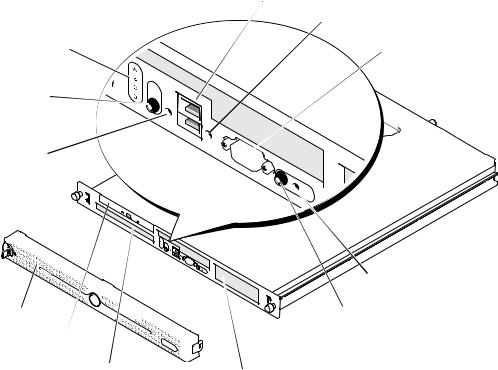
Front-Panel Features and Indicators
Figure 1-1 shows the controls, indicators, connectors, and features on the system front panel behind the optional bezel. (To remove the bezel, press the latch at the left end of the bezel. See "Opening the System" on page 46.) Table 1-2 provides component descriptions.
Figure 1-1. Front-Panel Features and Indicators
3
 4
4
2 |
5 |
1 
12 
 6
6
11 




 7
7
10 |
|
9 |
8 |
|
About Your System |
|
11 |
|
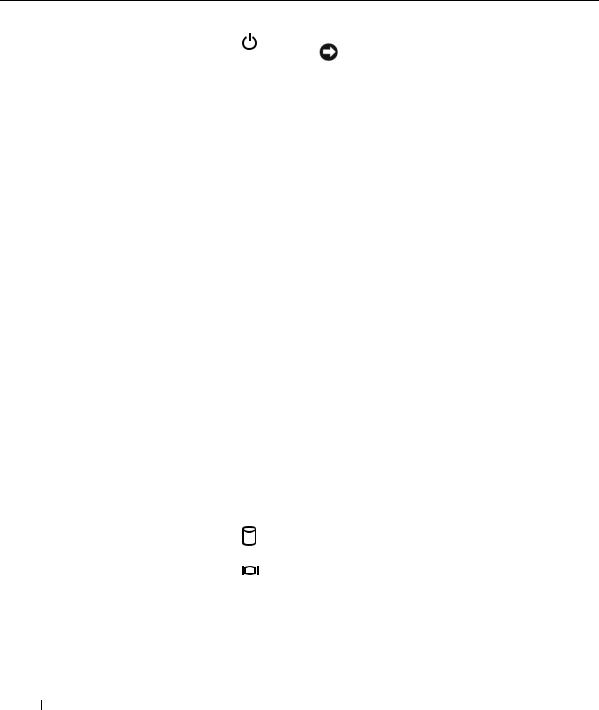
Table 1-2. Front-Panel Components
Item |
Component |
Icon |
Description |
|
|
|
|
1 |
Power-on indicator, power |
|
The power button turns system power off and on. |
|
button |
|
NOTICE: If you turn off the system using the power |
|
|
|
|
|
|
|
button and the system is running an ACPI-compliant |
|
|
|
operating system, the system can perform an orderly |
|
|
|
shutdown before power is turned off. If the power |
|
|
|
button is pressed for more than 4 seconds, the |
|
|
|
system power will turn off regardless of the current |
|
|
|
operating system state. If the system is not running |
|
|
|
an ACPI-compliant operating system, power is |
|
|
|
turned off immediately after the power button is |
|
|
|
pressed. |
|
|
|
The power button is enabled in the System Setup |
|
|
|
program. When disabled, the button can only turn the |
|
|
|
system power on. For more information, see "Using the |
|
|
|
System Setup Program" on page 29 and the operating |
|
|
|
system's documentation. |
|
|
|
The power-on indicator lights or blinks to indicate the |
|
|
|
status of power to the system. |
|
|
|
The power-on indicator lights when the system is on. |
|
|
|
The indicator is off when the system is off and power is |
|
|
|
disconnected from the system. The indicator blinks |
|
|
|
when the system is on but in standby state, or when the |
|
|
|
system is off but is still connected to the power source. |
|
|
|
To exit from the standby state, briefly press the power |
|
|
|
button. |
|
|
|
|
2 |
Diagnostic indicators (4) |
|
The diagnostic indicators aid in diagnosing and |
|
|
|
troubleshooting the system. For more information, see |
|
|
|
your Hardware Owner’s Manual. |
|
|
|
|
3 |
USB connectors (2) |
|
Connect USB 2.0-compliant devices to the system. |
|
|
|
|
4 |
Hard-drive activity indicator |
|
The green hard-drive activity indicator flashes when the |
|
|
|
hard drives are in use. |
|
|
|
|
5 |
Video connector |
|
Connects a monitor to the system. |
12 About Your System
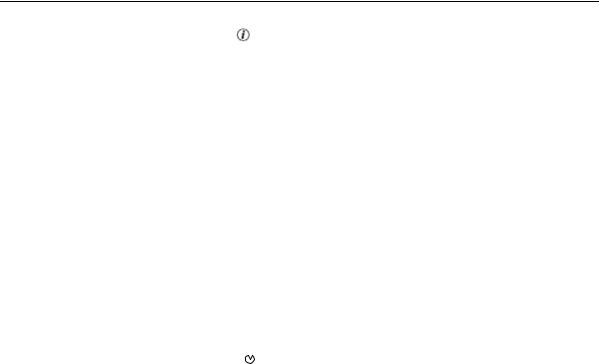
Table 1-2. Front-Panel Components (continued)
Item |
Component |
Icon |
Description |
|
|
|
|
6 |
System status indicator |
|
The blue system status indicator lights up during |
|
|
|
normal system operation. |
|
|
|
The amber system status indicator flashes when the |
|
|
|
system needs attention due to a system problem. |
|
|
|
|
7 |
System identification button |
|
You can use the system identification buttons on the |
|
|
|
front and back panels to locate a particular system |
|
|
|
within a rack. When one of these buttons is pushed, the |
|
|
|
blue system status indicators on the front and back |
|
|
|
panels blink until one of the buttons is pushed again. |
|
|
|
You can also use the systems management software to |
|
|
|
cause the indicators to flash to identify a particular |
|
|
|
system. |
|
|
|
|
8 |
Hard drive 1 |
|
Optional 3.5-inch SAS or SATA hard drive. |
|
|
|
|
9 |
Hard drive 0 |
|
A 3.5-inch SAS or SATA hard drive. |
|
|
|
|
10 |
Optical drive |
|
Optional. |
|
|
|
|
11 |
Bezel |
|
Optional |
|
|
|
|
12 |
NMI button |
|
The NMI button is used to troubleshoot software and |
|
|
|
device driver errors when using certain operating |
|
|
|
systems. This button can be pressed using the end of a |
|
|
|
paper clip. Use this button only if directed to do so by |
|
|
|
qualified support personnel or by the operating system's |
|
|
|
documentation. |
|
|
|
|
About Your System |
|
13 |
|
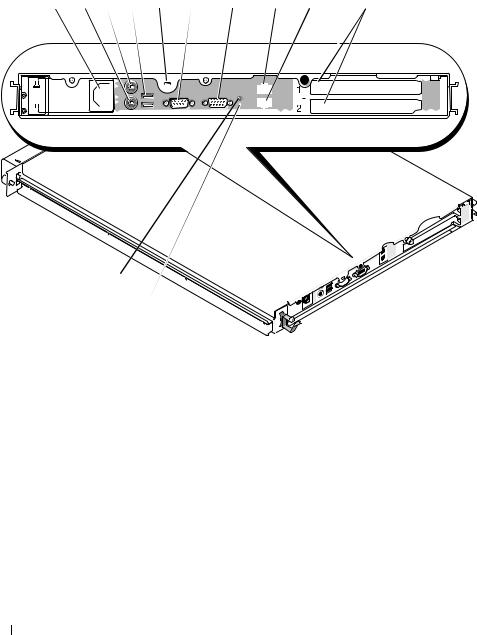
Back-Panel Features and Indicators
Figure 1-2 shows the controls, indicators, and connectors located on the system's back panel.
Figure 1-2. Back-Panel Features and Indicators
1 |
2 |
3 |
4 |
5 |
6 |
7 |
8 |
9 |
10 |
|
|
|
||||
|
|
|
|
|
|
|
|
|
|
|
|
|
|
|
|
|
|
|
|
|
|
|
|
|
|
|
|
|
|
|
|
|
|
|
|
|
|
|
|
|
|
|
|
|
|
|
|
|
|
|
|
|
|
|
|
|
|
|
|
|
|
|
|
|
|
|
|
|
|
|
|
|
|
|
|
|
|
|
|
|
|
|
|
|
|
|
|
|
|
|
|
|
|
|
|
|
|
|
|
|
|
|
|
|
|
|
|
|
|
|
|
|
|
|
|
|
|
|
12
|
11 |
|
|
|
|
1 |
power supply connector |
2 |
keyboard connector |
3 |
mouse connector |
4 |
USB connectors (2) |
5 |
Kensington lock |
6 |
serial connector |
7 |
video connector |
8 |
NIC1 connector |
9 |
NIC2 connector |
10 |
expansion slots (2) |
11 |
system status indicator |
12 |
system identification button |
Connecting External Devices
When connecting external devices to your system, follow these guidelines:
•Most devices must be connected to a specific connector and device drivers must be installed before the device operates properly. (Device drivers are normally included with your operating system software or with the device itself.) See the documentation that accompanied the device for specific installation and configuration instructions.
14 About Your System
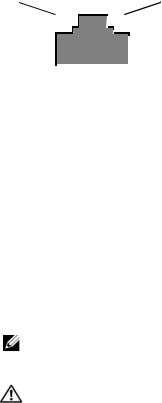
•Always attach an external device while your system and the device are turned off. Next, turn on any external devices before turning on the system (unless the documentation for the device specifies otherwise).
See "Using the System Setup Program" on page 29 for information about enabling, disabling, and configuring I/O ports and connectors.
NIC Indicator Codes
Each NIC on the back panel has an indicator that provides information on network activity and link status. See Figure 1-3. Table 1-3 lists the NIC indicator codes.
Figure 1-3. NIC Indicators
1 |
|
2 |
|||||||||||
|
|
|
|
|
|
|
|
|
|
|
|
|
|
|
|
|
|
|
|
|
|
|
|
|
|
|
|
|
|
|
|
|
|
|
|
|
|
|
|
|
|
|
|
|
|
|
|
|
|
|
|
|
|
|
|
|
|
|
|
|
|
|
|
|
|
|
|
|
|
|
|
|
|
|
|
|
|
|
|
|
|
|
|
1 link indicator |
2 |
activity indicator |
|
Table 1-3. |
NIC Indicator Codes |
|
|
|
|
|
|
Indicator |
|
Indicator Code |
|
|
|
||
Link and activity indicators are off. |
The NIC is not connected to the network. |
||
Link indicator is green. |
The NIC is connected to a valid link partner on the network. |
||
Activity indicator is blinking yellow. |
Network data is being sent or received. |
||
|
|
|
|
System Messages
System messages appear on the screen to notify you of a possible problem with the system. Table 1-4 lists the system messages that can occur and the probable cause and corrective action for each message.
NOTE: If you receive a system message that is not listed in Table 1-4, check the documentation for the application that is running when the message appears or the operating system's documentation for an explanation of the message and recommended action.
CAUTION: Only trained service technicians are authorized to remove the system cover and access any of the components inside the system. Before performing any procedure, see your Product Information Guide for complete information about safety precautions, working inside the computer and protecting against electrostatic discharge.
About Your System |
|
15 |
|

Table 1-4. System Messages
Message |
Causes |
Corrective Actions |
|
|
|
Amount of available memory |
The OS Install Mode option in the |
After the operating system is installed, |
limited to 256MB |
System Setup program is set to On. |
enter the System Setup program and set |
|
This limits the amount of available |
the OS Install Mode option to Off. See |
|
memory to 256 MB because some |
your Hardware Owner’s Manual for |
|
operating systems will not complete |
details. |
|
installation with more than 2 GB of |
|
|
system memory. |
|
|
|
|
Attempting to update |
Remote Configuration is in progress. |
Wait until the process is complete. |
Remote Configuration. |
|
|
Please wait.... |
|
|
|
|
|
BIOS Update Attempt |
Remote BIOS update attempt failed. |
Retry the BIOS update. If the problem |
Failed! |
|
persists, see "Getting Help" on page 103. |
|
|
|
Caution! NVRAM_CLR jumper |
NVRAM_CLR jumper is installed. |
Check the System Setup configuration |
is installed on system |
|
settings. See "Using the System Setup |
board. |
|
Program" on page 29. Remove the |
|
|
NVRAM_CLR jumper. See Figure 6-1 |
|
|
for jumper locations. |
|
|
|
Data error |
The diskette drive or hard drive |
For the operating system, run the |
|
cannot read the data. |
appropriate utility to check the file |
|
|
structure of the diskette drive or hard |
|
|
drive. |
|
|
See your operating system |
|
|
documentation for information on |
|
|
running these utilities. |
|
|
|
Decreasing available |
One or more memory modules might |
Reinstall the memory modules and, if |
memory |
be improperly seated or faulty. |
necessary, replace them. See "System |
|
|
Memory" on page 67. |
|
|
See "Troubleshooting System Memory" |
|
|
on page 88. |
|
|
|
Diskette read failure |
Faulty or improperly inserted diskette. Replace the diskette. |
|
|
|
|
Diskette subsystem reset |
Faulty diskette drive or optical drive |
Ensure that the diskette drive and |
failed |
controller. |
optical drive cables are properly |
|
|
connected. See "Troubleshooting a USB |
|
|
Device" on page 83 and |
|
|
"Troubleshooting an Optical Drive" on |
|
|
page 89. If the problem persists, see |
|
|
"Getting Help" on page 103. |
|
|
|
Drive not ready |
Diskette missing or improperly |
Reinsert or replace the diskette. |
|
inserted in diskette drive. |
|
16 About Your System

Table 1-4. System Messages (continued)
Message |
Causes |
Corrective Actions |
|
|
|
Error: Incorrect memory |
The installed memory modules are |
See "Memory Module Installation |
configuration. Ensure |
not matched pairs. |
Guidelines" on page 68. |
memory in slots DIMM1_A |
|
|
and DIMM1_B, DIMM2_A and |
|
|
DIMM2_B match identically |
|
|
in size, speed and rank. |
|
|
|
|
|
Error: Remote Access |
Faulty or improperly installed RAC. |
Ensure that the RAC is properly |
Controller initialization |
|
installed. See "Troubleshooting |
failure. |
|
Expansion Cards" on page 91. |
|
|
|
Error 8602: Auxiliary |
Loose or improperly connected mouse |
Replace the mouse. If the problem |
device failure. Verify |
or keyboard cable; faulty mouse or |
persists, replace the keyboard. |
that mouse and keyboard |
keyboard. |
|
are securely attached to |
|
|
correct connectors. |
|
|
|
|
|
Gate A20 failure |
Faulty keyboard controller (faulty |
See "Getting Help" on page 103. |
|
system board). |
|
General failure |
The operating system is unable to |
|
carry out the command. |
This message is usually followed by specific information. Take the appropriate action to resolve the problem.
IDE Primary drive 0 not found
Primary drive 0 set as Auto, no disk. |
Run the System Setup program to |
|
correct the settings. See "Using the |
|
System Setup Program" on page 29. |
Invalid memory |
Unsupported DIMMs are installed in |
configuration detected. |
the system, or the memory |
Potential for data |
configuration is incorrect. |
corruption exists! |
|
Replace or reconfigure the DIMMs. See "System Memory" on page 67 for memory configuration guidelines, a list of supported DIMMs, and supported memory configurations.
Keyboard controller |
Faulty keyboard controller (faulty |
See "Getting Help" on page 103. |
|
failure |
system board). |
|
|
|
|
|
|
Keyboard data line failure |
Loose or improperly connected |
Ensure that the keyboard is properly |
|
Keyboard failure |
keyboard cable; faulty keyboard; faulty |
connected. If the problem persists, |
|
keyboard controller. |
replace the keyboard. If the problem |
||
Keyboard stuck key failure |
|||
|
persists, see "Getting Help" on page 103. |
||
|
|
||
|
|
|
|
Keyboard fuse has failed. |
Keyboard fuse has failed. |
Replace the keyboard. |
|
|
Faulty system board. |
If the problem persists, the system board |
|
|
|
is faulty. See "Getting Help" on page 103. |
|
|
|
|
|
Manufacturing mode |
System is incorrectly configured. |
|
|
detected |
|
|
About Your System |
|
17 |
|

Table 1-4. System Messages (continued)
Message |
Causes |
Corrective Actions |
|
|
|
Memory address line |
Faulty or improperly installed memory |
Ensure that all memory modules are |
failure at address, read |
modules, or faulty system board. |
properly installed. See "Troubleshooting |
value expecting value |
|
System Memory" on page 88. If the |
Memory double word logic |
|
problem persists, see "Getting Help" on |
|
page 103. |
|
failure at address, read |
|
|
|
|
|
value expecting value |
|
|
Memory odd/even logic |
|
|
failure at start address |
|
|
to end address |
|
|
Memory write/read failure |
|
|
at address, read value |
|
|
expecting value |
|
|
|
|
|
Memory tests terminated by |
The spacebar was pressed during |
Information only. |
keystroke |
POST to terminate the memory test. |
|
|
|
|
No boot device available |
The system cannot find the diskette or |
If the diskette drive is your boot device, |
|
hard drive. |
ensure that a bootable disk is in the |
|
|
drive. |
|
|
If the hard drive is your boot device, |
|
|
ensure that the hard drive is installed, |
|
|
properly seated, and partitioned as a |
|
|
boot device. |
|
|
Enter the System Setup program and |
|
|
verify the boot sequence information. |
|
|
See your Hardware Owner’s Manual for |
|
|
details. |
|
|
|
No boot sector on |
The system configuration information |
Enter the System Setup program and |
hard-disk drive |
in the System Setup program might |
verify the system configuration |
|
be incorrect. |
information for the hard drive. See your |
|
|
Hardware Owner’s Manual for details. |
|
|
If the message continues to appear after |
|
|
verifying the information in the System |
|
|
Setup program, the operating system |
|
|
might have been corrupted. Reinstall the |
|
|
operating system. See your operating |
|
|
system documentation for reinstallation |
|
|
information. |
|
|
|
No timer tick interrupt |
A chip on the system board might be |
Run the system diagnostics. See |
|
malfunctioning. |
"Running the System Diagnostics" on |
|
|
page 93. |
18 About Your System

Table 1-4. System Messages (continued)
Message |
Causes |
Corrective Actions |
|
|
|
Not a boot diskette |
The operating system is trying to boot |
Insert a diskette that has a bootable |
|
from a diskette that does not have a |
operating system. |
|
bootable operating system installed |
|
|
on it. |
|
PCI BIOS failed to install PCI device BIOS (Option ROM) checksum failure is detected during shadowing.
Ensure that all appropriate cables are securely connected to the expansion cards. If the problem persists, see "Troubleshooting Expansion Cards" on page 91.
PCIe Degraded Link Width |
Faulty or improperly installed PCIe |
Reseat the PCIe cards. See "Expansion |
Error: Embedded |
card. |
Cards" on page 63. If the problem |
Bus#nn/Dev#nn/Funcn |
|
persists, see "Getting Help" on page 103. |
Expected Link Width is n |
|
|
Actual Link Width is n |
|
|
PCIe Degraded Link Width |
Faulty or improperly installed PCIe |
Reseat the PCIe card in the specified |
Error: Slot n |
card in the specified slot number. |
slot number. See "Expansion Cards" on |
Expected Link Width is n |
|
page 63. If the problem persists, see |
|
"Getting Help" on page 103. |
|
Actual Link Width is n |
|
|
|
|
|
|
|
|
PCIe Training Error: |
Faulty or improperly installed PCIe |
Reseat the PCIe cards. See "Expansion |
Embedded |
card. |
Cards" on page 63. If the problem |
Bus#nn/Dev#nn/Funcn |
|
persists, see "Getting Help" on page 103. |
PCIe Training Error: |
Faulty or improperly installed PCIe |
Reseat the PCIe card in the specified |
Slot n |
card in the specified slot number. |
slot number. See "Expansion Cards" on |
|
|
page 63. If the problem persists, see |
|
|
"Getting Help" on page 103. |
Plug & Play Configuration |
Error encountered in initializing PCI |
Error |
device; faulty system board. |
Install the NVRAM_CLR jumper and reboot the system. See Figure 6-1 for jumper location. Check for a BIOS update. If the problem persists, see "Troubleshooting Expansion Cards" on page 91. If the problem persists, see "Getting Help" on page 103.
Primary drive 0/1 |
Faulty drive. Parameters failure. |
Ensure that the hard drive cables are |
configuration error |
|
properly connected. See |
|
|
"Troubleshooting a Hard Drive" on |
|
|
page 90. |
About Your System |
|
19 |
|

Table 1-4. System Messages (continued)
Message |
Causes |
Corrective Actions |
|
|
|
Primary drive 0/1 failure |
Faulty drive. INT13 call failure from |
Ensure that the hard drive cables are |
|
the drive. |
properly connected. See |
|
|
"Troubleshooting a Hard Drive" on |
|
|
page 90. |
Read fault
Requested sector not found
The operating system cannot read from the diskette or hard drive, the system could not find a particular sector on the disk, or the requested sector is defective.
Replace the diskette. Ensure that the diskette and hard-drive cables are properly connected. See "Troubleshooting a USB Device" on page 83, "Troubleshooting a Hard Drive" on page 90, or "Troubleshooting a Hard Drive" on page 90 for the appropriate drive(s) installed in your system.
Remote Configuration |
System could not implement Remote |
Retry Remote Configuration. |
update attempt failed |
Configuration request. |
|
|
|
|
ROM bad checksum = address |
Faulty or improperly installed |
Remove and reseat the expansion cards. |
|
expansion card. |
See "Troubleshooting Expansion Cards" |
|
|
on page 91. |
|
|
|
SATA port 0/1 hard disk |
Faulty drive. Parameters failure. |
Ensure that the hard drive cables are |
drive configuration error |
|
properly connected. See |
|
|
"Troubleshooting a Hard Drive" on |
|
|
page 90. |
|
|
|
SATA port 0/1 hard disk |
Faulty drive. INT13 call failure from |
Ensure that the hard drive cables are |
drive failure |
the drive. |
properly connected. See |
SATA port 0/1 hard disk |
|
"Troubleshooting a Hard Drive" on |
|
page 90. |
|
drive auto-sensing error |
|
|
|
|
|
|
|
|
SATA Port 0/1 hard disk not |
SATA Port0/1 set as Auto, no disk |
Run the System Setup program to |
found |
installed. |
correct the settings. See "Using the |
|
|
System Setup Program" on page 29. |
Sector not found |
Faulty diskette or hard drive. |
Seek error
Seek operation failed
See "Troubleshooting a USB Device" on page 83, "Troubleshooting a Hard Drive" on page 90, or "Troubleshooting a Hard Drive" on page 90 for the appropriate drive installed in your system.
Shutdown failure |
Shutdown test failure. |
Ensure that all memory modules are |
|
|
properly installed. See "Troubleshooting |
|
|
System Memory" on page 88. If the |
|
|
problem persists, see "Getting Help" on |
|
|
page 103. |
20 About Your System
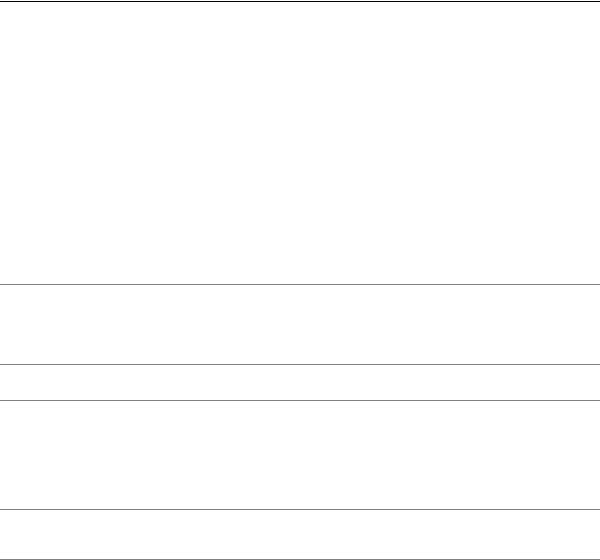
Table 1-4. System Messages (continued)
Message |
Causes |
Corrective Actions |
|
|
|
The amount of system |
Faulty memory module. |
See "Troubleshooting System Memory" |
memory has changed. |
|
on page 88. If the problem persists, see |
|
|
"Getting Help" on page 103. |
|
Information only, if you have changed |
|
|
the memory configuration. |
|
|
|
|
The amount of tested |
Invalid memory configuration. |
See "Memory Module Installation |
memory is below the |
|
Guidelines" on page 68. |
minimum system |
|
|
configuration. System |
|
|
halted! |
|
|
|
Faulty memory module. |
See "Troubleshooting System Memory" |
|
|
on page 88. If the problem persists, see |
|
|
"Getting Help" on page 103. |
|
|
|
Time-of-day clock stopped |
Faulty battery; faulty system board. |
See "Troubleshooting the System |
|
|
Battery" on page 86. If the problem |
|
|
persists, see "Getting Help" on page 103. |
Time-of-day not set - |
Incorrect Time or Date settings; faulty |
please run SETUP program |
system battery. |
Check the Time and Date settings. See "Using the System Setup Program" on page 29. If the problem persists, see "Troubleshooting the System Battery" on page 86.
Timer chip counter 2 |
Faulty system board. |
See "Getting Help" on page 103. |
failed |
|
|
Unexpected interrupt in |
Faulty or improperly installed memory |
protected mode |
modules or faulty system board. |
Ensure that all memory modules are properly installed. See "Memory Module Installation Guidelines" on page 68. If the problem persists, see "Troubleshooting System Memory" on page 88. If the problem persists, see "Getting Help" on page 103.
Utility partition not |
Utility partition is not available on the |
available |
hard disk |
Create a utility partition on the boot hard drive. See the CDs that came with your system.
Warning! No |
micro |
code |
Micro code update failed. |
Update the BIOS firmware. See "Getting |
update loaded for |
|
|
Help" on page 103. |
|
processor 0 |
|
|
|
|
About Your System |
|
21 |
|
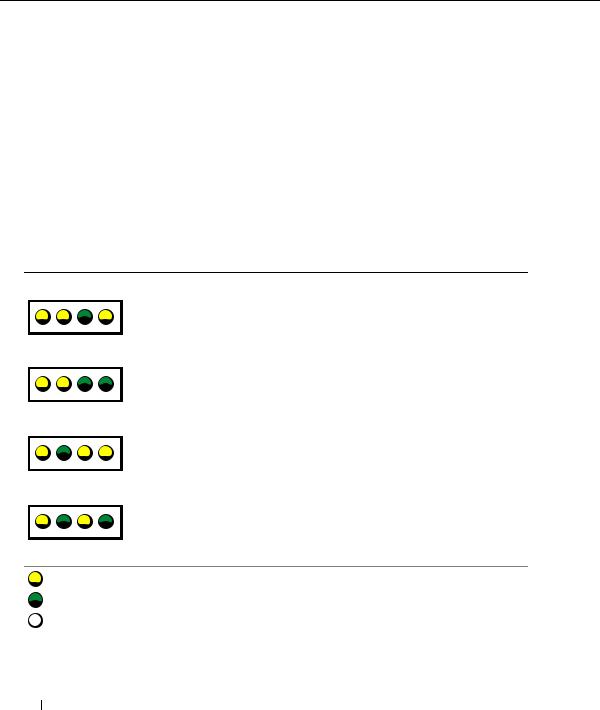
Table 1-4. System Messages (continued)
Message |
Causes |
Corrective Actions |
|
|
|
Write fault |
Faulty diskette, diskette drive, hard |
Replace the diskette. Ensure that the |
Write fault on selected |
drive. |
diskette drive and hard-drive cables are |
|
properly connected. See |
|
drive |
|
|
|
"Troubleshooting a USB Device" on |
|
|
|
|
|
|
page 83, "Troubleshooting a Hard Drive" |
|
|
on page 90, or "Troubleshooting a Hard |
|
|
Drive" on page 90 for the appropriate |
|
|
drive(s) installed in your system. |
|
|
|
Diagnostics Indicator Codes
The four diagnostics indicators on the system front panel display error codes during system startup. Table 1-5 lists the causes and possible corrective actions associated with these codes.
Table 1-5. Diagnostic Indicator Codes
Code |
Causes |
Corrective Action |
|
|
|
|
Possible processor failure. See "Troubleshooting the Microprocessor" on |
|
|
|
page 92. |
A B C D |
|
|
|
|
|
|
Memory failure. |
See "Troubleshooting System Memory" on |
|
|
page 88. |
A B C D |
|
|
|
|
|
|
Possible expansion card |
See "Troubleshooting Expansion Cards" on |
|
failure. |
page 91. |
A B C D |
|
|
|
|
|
|
Possible video card |
See "Troubleshooting Expansion Cards" on |
|
failure. |
page 91. |
A B C D
= y e l l o w
= g r e e n
= o f f
22 About Your System
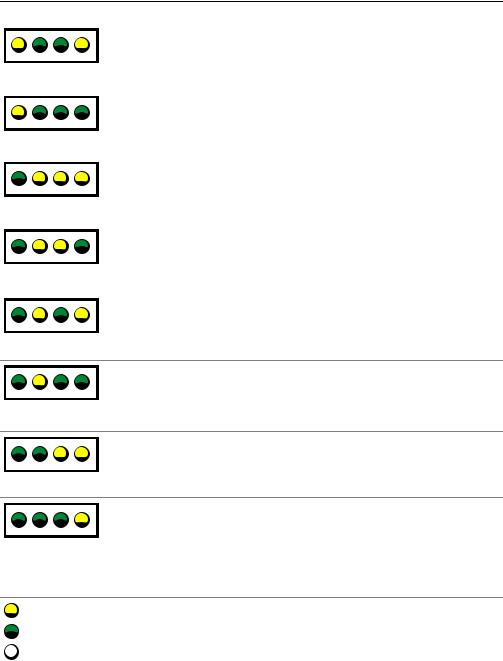
Table 1-5. Diagnostic Indicator Codes (continued)
Code |
Causes |
Corrective Action |
|
|
|
|
Diskette drive or hard |
Ensure that the diskette drive and hard-drive |
|
drive failure. |
are properly connected. See "Installing a Hard |
A B C D |
|
Drive" on page 56 for information on the drives |
|
installed in your system. |
|
|
|
|
|
Possible USB failure. |
See "Troubleshooting a USB Device" on |
|
|
page 83. |
A B C D |
|
|
|
|
|
|
No memory modules |
See "Troubleshooting System Memory" on |
|
detected. |
page 88. |
A B C D |
|
|
|
|
|
|
System board failure. |
See "Getting Help" on page 103. |
A B C D |
|
|
|
|
|
|
Memory configuration |
See "Troubleshooting System Memory" on |
|
error. |
page 88. |
A B C D |
|
|
Possible system board resource and/or system
board hardware failure.
A B C D
See "Troubleshooting IRQ Assignment Conflicts" on page 80. If the problem persists, see "Getting Help" on page 103.
Possible expansion card |
See "Troubleshooting Expansion Cards" on |
failure. |
page 91. |
A B C D
A B C D
Other failure. |
Ensure that the optical drive and hard drives |
|
are properly connected. See "Troubleshooting |
|
Your System" on page 79 for the appropriate |
|
drive installed in your system. |
|
If the problem persists, see "Getting Help" on |
|
page 103. |
=y e l l o w
=g r e e n
=o f f
About Your System |
|
23 |
|

Table 1-5. Diagnostic Indicator Codes (continued)
Code |
Causes |
Corrective Action |
The system is in a normal Information only.
operating condition after
POST.
A B C D
= y e l l o w
= g r e e n
= o f f
System Beep Codes
If an error that cannot be reported on the screen occurs during POST, the system may emit a series of beeps that identifies the problem.
NOTE: If the system boots without a keyboard, mouse, or monitor attached, the system does not issue beep codes related to those peripherals.
If a beep code is emitted, write down the series of beeps and then look it up in Figure 1-6. If you are unable to resolve the problem by looking up the meaning of the beep code, use system diagnostics to identify the possible cause. If you are still unable to resolve the problem, see "Getting Help" on page 103.
Table 1-6. System Beep Codes
Code |
Cause |
Corrective Action |
|
|
|
1-1-2 |
CPU register test failure |
See "Troubleshooting the Microprocessor" on |
|
|
page 92. |
|
|
|
1-1-3 |
CMOS write/read failure; faulty |
Faulty system board. See "Getting Help" on |
|
system board |
page 103. |
|
|
|
1-1-4 |
BIOS error |
Reflash the BIOS. |
|
|
|
1-2-1 |
Programmable interval-timer failure; |
Faulty system board. See "Getting Help" on |
|
faulty system board |
page 103. |
24 About Your System

Table 1-6. System Beep Codes (continued)
Code |
Cause |
Corrective Action |
|
|
|
1-2-2 |
DMA initialization failure |
See "Troubleshooting System Memory" on page 88. |
1-2-3 |
DMA page register write/read failure |
|
1-3-1 |
Main-memory refresh verification |
|
|
failure |
|
1-3-2 |
No memory installed |
|
1-3-3 |
Chip or data line failure in the first |
|
|
64 KB of main memory |
|
1-3-4 |
Odd/even logic failure in the first |
|
|
64 KB of main memory |
|
1-4-1 |
Address line failure in the first 64 KB |
|
|
of main memory |
|
1-4-2 |
Parity failure in the first 64 KB of |
|
|
main memory |
|
1-4-3 |
Fail-safe timer test failure |
|
1-4-4 |
Software NMI port test failure |
|
2-1-1 |
Bit failure in the first 64 KB of main |
|
through |
memory |
|
2-4-4 |
|
|
|
|
|
3-1-1 |
Slave DMA-register failure |
Faulty system board. See "Getting Help" on |
3-1-2 |
Master DMA-register failure |
page 103. |
|
||
3-1-3 |
Master interrupt-mask register |
|
|
failure |
|
3-1-4 |
Slave interrupt-mask register failure |
|
3-2-2 |
Interrupt vector loading failure |
|
3-2-4 |
Keyboard-controller test failure |
|
3-3-1 |
CMOS failure |
|
3-3-2 |
System configuration check failure |
|
3-3-3 |
Keyboard controller not detected |
|
3-3-4 |
Video memory test failure |
|
3-4-1 |
Screen initialization failure |
|
3-4-2 |
Screen-retrace test failure |
|
3-4-3 |
Video ROM search failure |
|
About Your System |
|
25 |
|
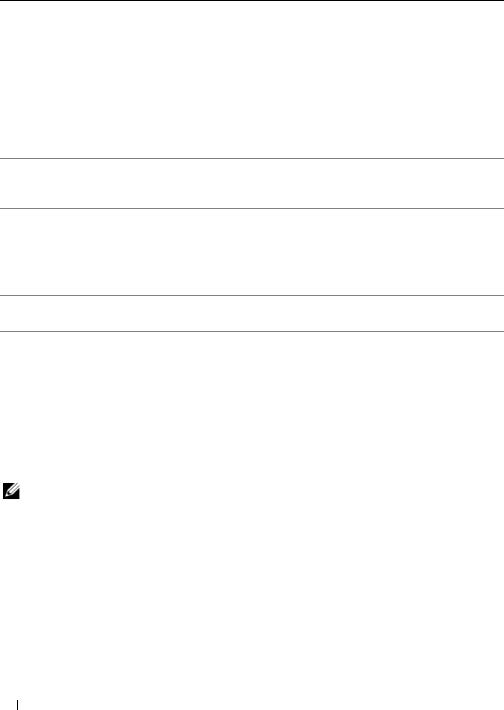
Table 1-6. System Beep Codes (continued)
Code |
Cause |
Corrective Action |
|
|
|
4-2-1 |
No timer tick |
Faulty system board. See "Getting Help" on |
4-2-2 |
Shutdown test failure |
page 103. |
|
||
4-2-3 |
Gate A20 failure |
|
|
|
|
4-2-4 |
Unexpected interrupt in protected |
See "Troubleshooting Expansion Cards" on |
|
mode |
page 91. |
|
|
|
4-3-1 |
Improperly installed or faulty |
See "Troubleshooting System Memory" on page 88. |
|
memory modules |
|
4-3-2 No memory modules installed in the first memory module connector
Install a memory module in the first memory module connector. See "System Memory" on page 67.
4-3-3 |
Faulty system board |
Faulty system board. See "Getting Help" on |
|
|
page 103. |
|
|
|
4-3-4 |
Time-of-day clock stopped |
See "Troubleshooting System Memory" on page 88. |
|
|
If the problem persists, see "Getting Help" on |
|
|
page 103. |
4-4-1 Super I/O chip failure; faulty system board
Faulty system board. See "Getting Help" on page 103.
4-4-4 |
Cache test failure; faulty processor See "Troubleshooting the Microprocessor" on |
|
page 92. |
|
|
Warning Messages
A warning message alerts you to a possible problem and prompts you to respond before the system continues a task. For example, before you format a diskette, a message will warn you that you may lose all data on the diskette. Warning messages usually interrupt the task and require you to respond by typing y (yes) or n (no).
NOTE: Warning messages are generated by either the application or the operating system. For more information, see the documentation that accompanied the operating system or application.
Diagnostics Messages
When you run system diagnostics, an error message may result. Diagnostic error messages are not covered in this section. Record the message on a copy of the Diagnostics Checklist in "Getting Help" on page 103, and then follow the instructions in that section for obtaining technical assistance.
26 About Your System
Alert Messages
Systems management software generates alert messages for your system. Alert messages include information, status, warning, and failure messages for drive, temperature, fan, and power conditions. For more information, see the systems management software documentation.
About Your System |
|
27 |
|

28 About Your System
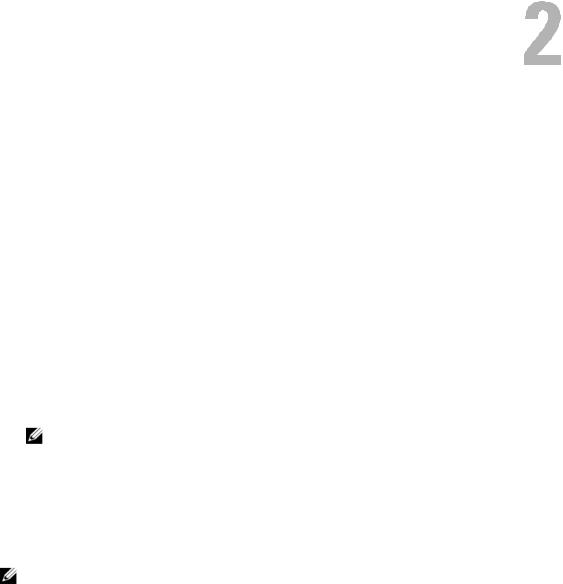
Using the System Setup Program
After you set up your system, run the System Setup program to familiarize yourself with your system configuration and optional settings. Record the information for future reference.
You can use the System Setup program to:
•Change the system configuration stored in NVRAM after you add, change, or remove hardware
•Set or change user-selectable options—for example, the time or date
•Enable or disable integrated devices
•Correct discrepancies between the installed hardware and configuration settings
Entering the System Setup Program
1Turn on or restart your system.
2Press <F2> immediately after you see the following message:
<F2> = System Setup
If your operating system begins to load before you press <F2>, allow the system to finish booting, and then restart your system and try again.
NOTE: To ensure an orderly system shutdown, see the documentation that accompanied your operating system.
Responding to Error Messages
You can enter the System Setup program by responding to certain error messages. If an error message appears while the system is booting, make a note of the message. Before entering the System Setup program, see "System Messages" on page 15 for an explanation of the message and suggestions for correcting errors.
NOTE: After installing a memory upgrade, it is normal for your system to send a message the first time you start your system.
Using the System Setup Program
Table 2-1 lists the keys that you use to view or change information on the System Setup program screens and to exit the program.
Using the System Setup Program |
29 |

Table 2-1. System Setup Program Navigation Keys
Keys |
Action |
|
|
Up arrow or <Shift><Tab> |
Moves to the previous field. |
|
|
Down arrow or <Tab> |
Moves to the next field. |
|
|
Spacebar, <+>, <–>, left and |
Cycles through the settings in a field. In many fields, |
right arrows |
you can also type the appropriate value. |
|
|
<Esc> |
Exits the System Setup program and restarts the |
|
system if any changes were made. |
|
|
<F1> |
Displays the System Setup program's help file. |
|
|
NOTE: For most of the options, any changes that you make are recorded but do not take effect until you restart the system.
System Setup Options
Main Screen
When you enter the System Setup program, the main System Setup program screen appears (see Figure 2-1).
30 Using the System Setup Program
